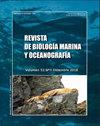Variación estacional del nivel del mar en el Archipiélago de San Andrés, Providencia y Santa Catalina, Mar Caribe
IF 0.5
4区 生物学
Q4 MARINE & FRESHWATER BIOLOGY
引用次数: 2
Abstract
espanolEl ciclo estacional del nivel del mar fue analizado en el Archipielago de San Andres, Providencia y Santa Catalina en el Mar Caribe con base en 22 anos de topografia dinamica absoluta. Se encontro gran variacion espacial en el espectro estacional del nivel del mar en las 9 principales geoformas que componen el archipielago dependiendo de su posicion meridional y como consecuencia de diferentes forzantes de este ciclo presentes en la Cuenca Colombia. La variacion anual del nivel del mar tiene un rango minimo de 2,7 cm en Quitasueno y un rango maximo de 9,5 cm en Roncador. En el norte del archipielago el ciclo estacional es maximo entre julio y agosto, y minimo entre enero y marzo; por el contrario en el sur del archipielago el ciclo estacional es maximo entre febrero y marzo y minimo entre agosto y septiembre. El ciclo estacional explica entre el 3 y el 23% de la variacion mensual del nivel del mar en el archipielago y no es constante en el tiempo; se encontraron cambios de hasta 3,6 cm en amplitud y de 83o de fase cuando el ciclo anual fue evaluado fraccionando la serie de tiempo en segmentos de 5 anos. La contribucion del ciclo estacional debe incluirse para la evaluacion de riesgos asociada a valores extremos del nivel del mar en el archipielago. EnglishThe sea level seasonal cycle was assessed in the San Andres, Providencia and Santa Catalina Archipelago in the Caribbean Sea using 22 years of absolute dynamic topography. Large spatial variability was found in the sea level seasonal spectrum in the 9 most important geographical features that constitute the archipelago, depending on their meridional position and as consequence of different forcings for this cycle present in the Colombian Basin. The sea level annual variation has a minimal range of 2.7 cm in Quitasueno and a maximum range of 9.5 cm in Roncador. The seasonal cycle is maximum in July-August and minimum in January-March toward the north of the archipelago; on the contrary, the seasonal cycle is maximum in February-March and minimum in August-September toward the south of the archipelago. The seasonal cycle explains between the 3 and 23% of the monthly sea level variation in the archipelago and it is not steady in time; changes up to 3.6 cm were found in the amplitude and 83o in the phase lag when the annual cycle was assessed fractionating the time series in 5-year segments. The seasonal cycle contribution must be included in the archipelago's risk assessment associated to sea level extreme values.加勒比海圣安德烈斯、普罗维登西亚和圣卡塔琳娜群岛海平面的季节变化
根据22年的绝对动态地形,分析了加勒比海圣安德烈斯群岛、普罗维登西亚群岛和圣卡塔琳娜群岛的海平面季节性循环。由于哥伦比亚盆地存在不同的强迫因素,构成群岛的9个主要地貌的海平面季节谱存在很大的空间变化,这取决于它们的南部位置。每年的海平面变化在Quitasueno最低为2.7厘米,在Roncador最高为9.5厘米。在群岛北部,季节周期在7月至8月之间最高,1月至3月之间最低;相比之下,在群岛的南部,季节周期在2月至3月之间最大,在8月至9月之间最小。季节周期解释了群岛海平面每月变化的3 - 23%,并且在时间上不是恒定的;在本研究中,我们分析了在不同的时间序列中,在不同的时间序列中,在不同的时间序列中,在不同的时间序列中,在不同的时间序列中,在不同的时间序列中,在不同的时间序列中,在不同的时间序列中,在不同的时间序列中。在评估群岛极端海平面值的风险时,应包括季节周期的贡献。= =地理= =根据美国人口普查,该地区的总面积为,其中土地和水(0.741平方公里)是土地。在构成群岛的9个最重要的地理特征的海平面季节谱中发现了广泛的空间变化,这取决于它们的南部位置和哥伦比亚盆地中存在的这个循环的不同力量的后果。= =地理= =根据美国人口普查局的数据,该镇总面积为,其中土地和(1.1%)水。7月至8月的季节周期最高,1月至3月的季节周期最低;= =地理= =根据美国人口普查局的数据,该县总面积为,其中土地和(1.3%)水。季节周期解释了群岛3 - 23%的月海平面变化,但时间并不稳定;当评估年度周期时,将时间序列划分为5年段时,振幅变化高达3.6 cm,相位滞后变化为83 cm。季节周期贡献必须包括在群岛与海平面极端值相关的风险评估中。
本文章由计算机程序翻译,如有差异,请以英文原文为准。
求助全文
约1分钟内获得全文
求助全文
来源期刊
CiteScore
0.70
自引率
0.00%
发文量
41
审稿时长
12 months
期刊介绍:
Publicar desde una perspectiva científica, artículos originales, decididos por un proceso de revisión por pares, invitando a expertos de reconocido prestigio en el área. Los trabajos publicados se caracterizarán por su solidez teórica-metodológica, actualidad y relevancia para las ciencias marinas.
Se reciben trabajos inéditos derivados de la investigación científica realizada en ambientes marinos y estuarios, en formato de Revisión, Artículos, Notas Científicas, y Obituarios en las siguientes disciplinas::
Biología-Ecología marina
Oceanografía física, química y biológica
Contaminación marina
Geología marina
Sistemática, Faunística y Biogeografía Marina
Manejo Costero
Acuicultura marina
Pesquería marina.

 求助内容:
求助内容: 应助结果提醒方式:
应助结果提醒方式:


